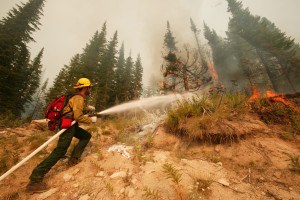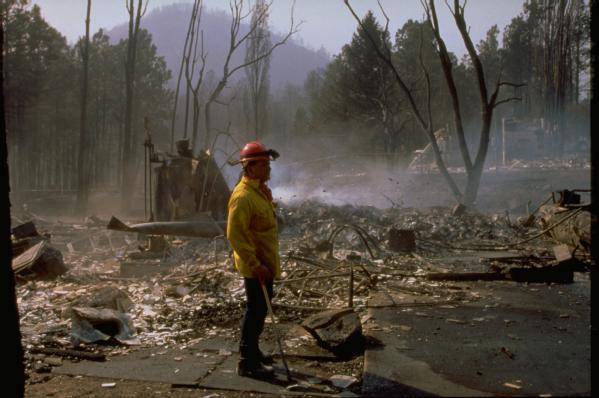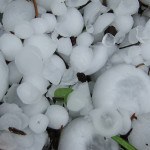When a forest fire threatens your house and you have minutes to run, do you know what you plan to grab besides your family?
The photo albums? Computer hard drive? Tax records? Gun collection? Clean underwear?
The U.S. Forest Service faces a much bigger version of that question, reported the Missoulian. When wildfire starts, does it deploy its army of yellow-shirted initial attack forces, or let trees burn? Does it chase every smoke on the horizon or concentrate on defending homes? And who gets a say in the decision?
Jim Hubbard spent years in the Forest Service pondering those questions. During a visit to Missoula, he said we need to start thinking about some new answers – fast.
“We have 17 Type I incident commanders (the most experienced, big-fire team leaders), and every year they say ‘I’ve never seen that before,”‘ Hubbard said during a presentation at the University of Montana. “Each one of these guys has 25 years-plus experience. That gets our attention.”

Part of those debriefings dwell on how wildfires have changed in longer summers, drier landscapes and beetle-killed tree stands. But they also consider how the Forest Service has (or hasn’t) been able to get to its year-round land-management duties while the agency’s budget has been drained by firefighting costs. They look at how county commissions have guided home-building in fire-prone areas, and what kinds of support might be available from state or local firefighters. And they wonder what the long-term vision of all this work should look like.
Hubbard spent 11 years as deputy chief of the Forest Service in charge of fire and aviation as well as relations with state and private foresters. He also was Colorado’s state forester for 20 years.
“We haven’t defined our performance-based outcomes yet,” Hubbard told the audience at the annual Mike and Mabelle Hardy Fire Management Lecture. That doesn’t mean picking a number of acres cleared of hazardous fuels or logged each year. It does mean setting out bigger goals for what risks are worth taking, whose interests are at stake, and what actions are even possible.
That involves things as basic as having up-to-date maps showing where houses have been built, where old-growth tree stands remain and where forest activities are planned.
“We need to know what areas to protect, what places are less important,” Hubbard said. “If everything is wildland-urban interface, you can’t make suppression decisions. You need to hear from the community, the county commissioners, the sheriff. Because we don’t want to use unnecessary exposure (of firefighters) that won’t get the results we’re after.”
Hubbard authored what’s known as the “Hubbard Letter” in 2012, telling federal fire bosses to launch initial attacks on all public-land fires that summer, including those in designated wilderness
“We expect above-normal, significant fire potential for many areas of the country to result in suppression costs that exceed the 10-year average appropriation,” Hubbard wrote at the time.
“Given the unique circumstances we face in 2012, I expect regional forester approval of any suppression strategy that includes restoration objectives. I acknowledge this is not a desirable approach in the long-run.”
And five years later, Hubbard confirmed that final opinion before a ballroom full of firefighters.
“Maybe some of that fire needed to run its course,” Hubbard said in Missoula. “Let’s tear up that Hubbard letter.”
Retired Montana State Forester Don Artley was one of those in the room with Hubbard. He echoed the need to be clear about what the big-picture goals should be. Part of that means understanding how fragile those goals are.
“We are making great plans about how we want the landscape to look, and they can all be for naught once a fire starts,” Artley said. “If it starts under hot, dry and windy conditions, we can’t risk direct action. Other times, it might be best to just monitor the fire’s progress. And we need more public acceptance of that process. We used to call it `let-burn,’ and everyone understood that. But the Forest Service was uncomfortable with that wording – it thought it meant we weren’t doing anything. Now they talk about ‘prescribed natural fire,’ and the public says ‘What are you talking about?’ ”
One thing Hubbard was talking about was “unplanned wildfire management.” That seemingly self-contradictory phrase grows out of the Forest Service’s falling budgets, where district rangers with land treatment projects in the works calculate the probability that a fire might burn something productively. For example, if a low-intensity wildfire runs through a hillside slated for a hazardous-fuels reduction burn, that’s one less project the district has to pay for.
“Our scientific ability to predict fire behavior has increased by orders of magnitude every year,” said Jeff Jahnke, a retired state forester with experience in Alaska, Colorado and Montana. “So the challenge is, can an incident commander plan the best way to suppress a fire and get resource benefits out of it at the same time?”
Nobody wants to appear to gamble with public safety, even though Hubbard pointed out every time someone drives a car, they gamble on avoiding wrecks. Allowing more prescribed burns might mean days of smoke in a city’s airshed during the spring or fall. But it might also mean fewer months of smoke during the summer if those small burns lessen the risk of bigger wildfires.
“If we don’t manage unplanned wildfires, we can’t get ahead of land treatment,” Hubbard said. “You’re going to fight fire a little differently in the future. You have to have buy-in.”
Was this article valuable?
Here are more articles you may enjoy.


 Sanofi to Pay $100 Million to Settle Zantac Cancer Lawsuits
Sanofi to Pay $100 Million to Settle Zantac Cancer Lawsuits  DraftKings Sued Over ‘Risk-Free’ Bets That Were Anything But
DraftKings Sued Over ‘Risk-Free’ Bets That Were Anything But  Report Using Aerial Imagery Keys in on Hailstorm Risks to Colorado Homes
Report Using Aerial Imagery Keys in on Hailstorm Risks to Colorado Homes  Harvard Study Again Stirs the Pot on Demotech Ratings of Florida Carriers
Harvard Study Again Stirs the Pot on Demotech Ratings of Florida Carriers 